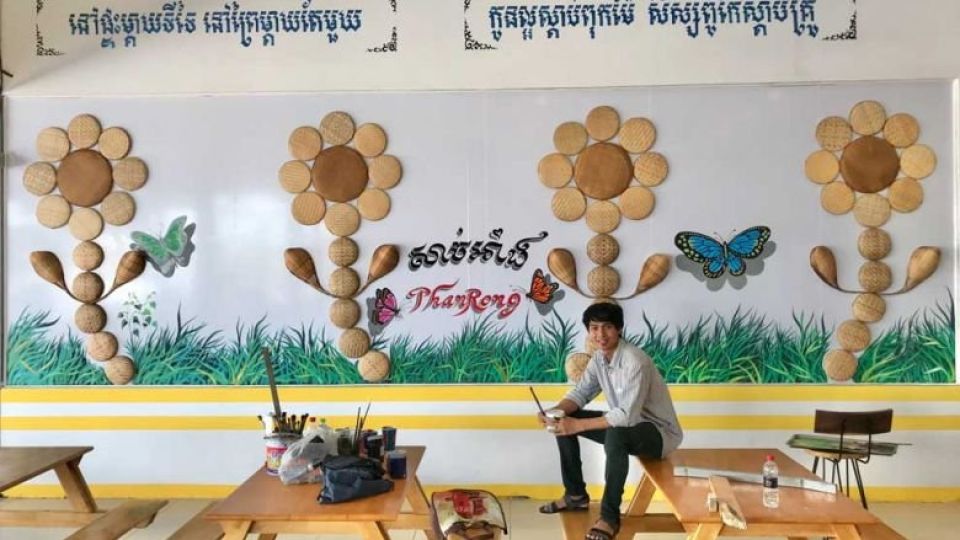August 24, 2023
PHNOM PENH – In a captivating display of artistic prowess, 38-year-old artist Nak Nang skilfully designs a painting, meticulously crafting Khmer syllabics by hand with breath-taking beauty.
Each stroke of the calligrapher’s brush breathes life into the ancient Khmer script, transforming it into a work of art that resonates with cultural heritage and artistic finesse.
The result is a logo that not only symbolises the essence of Khmer culture but also stands as a testament to the enduring artistry of calligraphy in the digital age, where every stroke is a brush with tradition and elegance.
“In the digital age, where computer technology designs nearly everything, including calligraphy in various languages, Khmer calligraphy art still finds support among aficionados of handmade and distinctive art,” said Nang, who is at the forefront of this Khmer calligraphy.
With a background in Modern Painting from the Royal School of Fine Arts and further education at the National Institute of Education in 2009, Nang has been devotedly honing his craft.
Beyond his work at the Regional Pedagogy Hun Sen of Kandal Province, he’s opened his own workshop, where he delves into various art forms, from sculpture to painting and logo design, all tailored to the unique needs of his clients.
Yet what truly sets Nang apart is his unparalleled skill in Khmer calligraphy, transforming this ancient script into a mesmerising art form.
“Calligraphy can be both a hobby and a talent,” he told The Post. Starting with a curiosity sparked during his school days, Nang embarked on a journey to master this delicate art. He diligently practised each of the 33 Khmer calligraphy alphabets, following the intricate rules of rounded styles.
He explained that the rounded font is categorised into four sizes: half-size font, one-size font, one-and-a-half-size font, and two-size font.
The half-size font includes only one letter, “Ror”, while the two-size fonts are “Chhor” and “Nor”. The one-and-a-half-size fonts are “Khhor”, “Nhor”, “Thor”, “Yor”, “Lor”, “Sor”, “Hor”, and “Lor”, with the rest being one-size fonts.
“When we understand the rules, we can engrave the calligraphy beautifully and maintain the proper order of each character,” said Nang.
The native of Kampong Cham province says he can create over 10 different round character patterns, and when it comes to square patterns, he can generate even more variations.
Recent years have witnessed a surge in demand for Nang’s skill. The expertise he offers is sought after by affluent individuals who commission exclusive designs. This trend underscores the enduring allure of hand-crafted artistry even in our technology-driven age.
“In the last four to five years, even when printing wedding or ceremonial invitations, guests often request calligraphy featuring a unique monogram. People frequently commission something exclusive,” he said.
Despite the prevalence of printed posters and banners, Nang asserts that they all originate from hand-carved designs.
He explains that the choice often depends on the budget and timeline of the company or enterprise owner. Some prefer computer-assisted design and printing, which can offer more than manual drawing alone.
Digital production professionals are, in essence, artists specialising in this form of design. Designers need to understand how to apply shadows, light and other techniques.
Drawing from his many years of experience, Nang can write calligraphy directly on walls without the need to pre-write the letters, simply sketching the lines according to the desired pattern.
However, he advises aspiring calligraphers to start by drafting with a pencil or chalk before transitioning to formal writing.
He contends that hand-painted art holds the same allure as digital creations, and Cambodians now highly cherish traditional art.
Nang’s expertise extends beyond traditional forms. He’s ventured into creating new fonts for use in Unicode, each character resembling a traditional Khmer sculpture.
These fonts are poised to become a national symbol, a fusion of tradition and modernity, and a testament to Nang’s dedication to his craft and nation.
“Some creators of Unicode fonts have approached me to design a font that incorporates traditional Khmer patterns,” Nang shared. “There are four types of ornaments, such as ‘kbachphnites’, ‘kbachphniangkor’, ‘kbachphnivoa’, and ‘kbachphnipleung’.”
“Our goal is to create a Unicode font that can serve as a national symbol. When we use these fonts, it results in elegant and straightforward writing,” he told The Post.
Although Nang devotes a substantial amount of time to sculpt and adorn each alphabet character, with each character taking three to four hours to complete, he has already finished carving all “kbachphnites” characters.
For “kbachphniangkor”, he says it requires more time compared to other “kbach” styles because of its complexity, and he aims for a high level of detail on each character.
“I dedicate my personal time to creating these fonts for free use because I seek nothing in return but to serve our nation,” the sculptor says with pride, noting that he can easily offer a range of logo engraving services without the need for both drawing and printing.
“Recently, there has been support from people who value literature, painting and art,” he added.
In a tech-driven world, Nang’s tale is a poignant reminder that a calligrapher’s strokes embody tradition and elegance, captivating those who cherish handmade, distinctive art.


